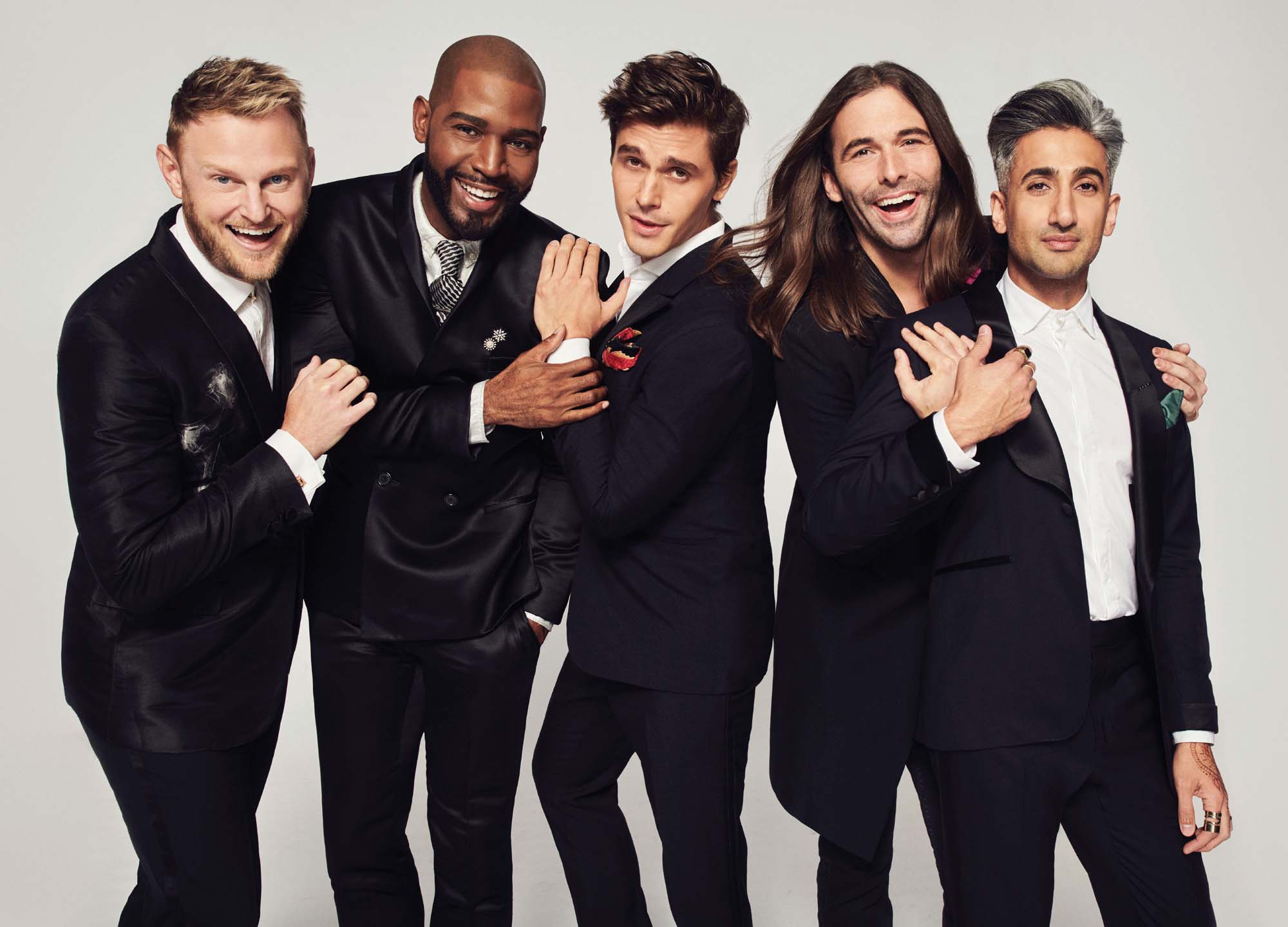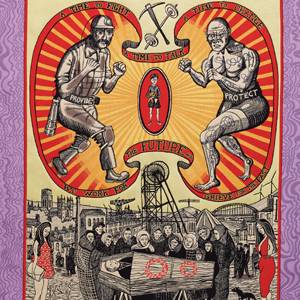
This article is a preview from the Spring 2018 edition of New Humanist.
In popular culture, it can often seem as if time doesn’t operate in the same way as it does in real life. A scene from the 1938 screwball comedy Bringing Up Baby can so accurately represent the way women are still patronised by men that it could have been shot yesterday, while an episode of Friends from 1999, which seems to show that there are almost no black people living in New York City, can feel as if it was made a hundred years ago.
Nowhere is this effect more apparent than with the hit American reality television show Queer Eye for the Straight Guy, first broadcast in 2003. Flip phones feature heavily in its opening titles, and the camp stylings of its cast of a “fab five” of gay men who make over a different straight man each episode make it feel much older than its 15 years. The fashion advice alone makes it seem from another time: at one point in the first episode, “fashion savant” and fab five member Carson Kressley advises a straight man that he can absolutely wear a denim jacket with jeans, as long as only one of the pieces is acid-washed.
Yet for all its silliness, Queer Eye was a radical cultural intervention. It was a hugely popular reality TV show with an entirely out gay cast, at a time when no US states had yet legalised same-sex marriage (Massachussetts was the first, in May 2004.) Kressley commented on this in a 2013 interview: “The show brought gay people into the living rooms and the bedrooms of millions of people across America.”
Queer Eye didn’t set out to be political. Although its creator David Collins wanted to improve screen representation, he was primarily trying to make a popular reality series. Ted Allen, the “food and wine connoisseur” of the original fab five, said in an interview with the Huffington Post in 2015: “When we made Queer Eye we never thought of ourselves as important, or as activists. We were proud of being out.” Yet the cast received thousands of letters from gay kids, he explained, for whom the show had made revealing their own sexuality to their families easier. “They wrote to say, ‘Thank you for putting some gay people on TV who my parents can actually like’.”
In fact, Allen was himself doubtful about the title of the programme before it was first broadcast, since he felt that “queer” was such a rarely used and political word that it would limit the show’s appeal. Once Queer Eye became a hit and a cultural phenomenon (copied by reality producers everywhere and parodied in New Yorker cartoons) he found it amusing watching conservative news anchors having to say the word on air for the first time.
Watching the series in 2018 is a slightly uncomfortable experience – the general atmosphere of the programme can at times seem snide and slightly bullying, with the fab five mocking a straight makeover subject’s hair as “like a girl’s”, forcing him to wear a T-shirt that reads “I <3 NY BOYs” as a joke, and boiling up his soiled jockstrap with herbs to serve as a stock for soup. Allen, Kressley and the original cast have also been criticised for perpetuating reductive stereotypes of what gay men are like, and it’s true there is a lot of camp hand-waving and shouts of “Fabulous, darling!” But the hosts are also funny and warm, with strong on-screen chemistry, and they very obviously produced good outcomes for their straight makeover subjects. It was, and still is, brilliant entertainment, which helped to move public opinion in a more progressive direction.
Reality TV has a well-deserved reputation for terrible behaviour, manipulative producers and awful screaming matches. Shows from Survivor to Celebrity Big Brother routinely reveal the worst of human nature to millions of viewers, all appealing to a sense of voyeurism mixed with a cosy feeling of “rather you than me”. However, there is a quieter, less gory strand of reality TV, and, as big-budget dramas like Game of Thrones hoover up the majority of networks’ budgets, this “nice” element is surviving the cuts.
Programmes like Terrace House and the Great British Bake Off fall into this category. The former is a Japanese reality show, first aired there in 2012 and revived in 2015 by Netflix. Its most recent series focuses on a group of young people, mostly students and young professionals, who share a house in Tokyo. Very little happens: they go to work and university, they cook meals together, go on low-key dates, and resolve the few conflicts that arise with mature, easygoing conversations. Yet somehow the cast’s geniality is compelling, and it’s become a cult hit in Britain and the US.
Likewise, The Great British Bake Off, with its pastel aesthetic and safe, bawdy puns, sounds on paper like it would bore the pants off most viewers, who have been taught by the later series of Big Brother and by I’m a Celebrity Get Me Out of Here to demand on-air sex and live bug-eating from their reality television. But it works, and millions tune in to find out if a cake has a soggy bottom or not.
Given that “nice” reality TV is experiencing a revival, it is unsurprising that Netflix have decided to bring back Queer Eye in 2018. In many ways, it is unchanged from the original: a new fab five of well-groomed gay experts have been cast (with their specialties once more in food and wine, grooming, interior design, fashion and culture), and in each episode they help an unstylish individual to up their game. The main difference is in the location: they have traded New York for Atlanta, Georgia, and for some episodes venture out of the city into more rural areas.
I was wary about the reincarnation of Queer Eye. So much has moved on in terms of LGBT representation and rights since the original series that I wondered what more it could have to say – isn’t the idea of a gay man having to help a straight man choose a decent shirt a bit dated?
Fortunately, the producers have anticipated this, and have subtly refocused the show for the “woke” 2018 audience. The fab five no longer just give advice on clothing and haircuts: they talk with their subjects about their insecurities around conventional ideas of masculinity, about the difficulties of being a good father, and about reconciling contradictory aspects of their identity.
In a particularly moving episode, the hosts work with a police officer, who initially isn’t comfortable with the fab five’s Karamo Brown and Tan France, who are of black and Asian descent respectively. Indeed, the officer’s friend pulls their car over to the side of the road as a “joke”, and we see the entirely justifiable fear of these two men of colour as a white cop orders them out of the vehicle, only for the tension to be defused as the gag is revealed. Later, Brown has a long conversation with their makeover subject about race, police brutality and their mutual fears – it’s surprisingly deep and moving for a supposedly lighthearted reality show.
There are other moments, too, where this revived version of Queer Eye chooses to tackle difficult issues head on: with an introverted man who is terrified of being touched by these extrovert gay men, for instance, or with an evangelical Christian whom interior designer Bobby Berk asks directly if his church hates gay people.
Progress has undoubtedly been made since the original series of Queer Eye aired – not least in the legalisation of same-sex marriage in the US and UK. But this revival refuses to be satisfied, and keeps pushing for better conversations at the intersection of sexuality, masculinity, race and intimacy. It was always a radical idea for entertainment, and its battles are far from over. Suicide rates among young gay men remain high, there are still countries around the world where homosexuality is criminalised, and homophobic bullying is still present in many schools. As the first episode declares: “The original show was fighting for tolerance. We’re fighting for acceptance.”

